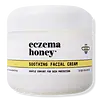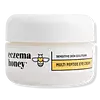What's inside
What's inside
 Key Ingredients
Key Ingredients

 Benefits
Benefits

 Concerns
Concerns

 Ingredients Side-by-side
Ingredients Side-by-side

Water
Skin ConditioningAloe Barbadensis Leaf Juice
Skin ConditioningCocos Nucifera Oil
MaskingGlycerin
HumectantCetearyl Alcohol
EmollientCaprylic/Capric Triglyceride
MaskingHelianthus Annuus Seed Oil
EmollientGlyceryl Stearate
EmollientRosa Canina Seed Oil
EmollientPolysorbate 60
EmulsifyingStearic Acid
CleansingHoney
HumectantAvena Sativa Kernel Flour
AbrasivePanthenol
Skin ConditioningSodium Hyaluronate
HumectantNiacinamide
SmoothingAnthemis Nobilis Flower Extract
MaskingCalendula Officinalis Flower Extract
MaskingCamellia Sinensis Leaf Extract
AntimicrobialVaccinium Corymbosum Fruit Extract
Skin ConditioningMacrocystis Pyrifera Extract
Skin ConditioningSodium Phytate
Xanthan Gum
EmulsifyingTocopheryl Acetate
AntioxidantPhenoxyethanol
PreservativeCaprylyl Glycol
EmollientEthylhexylglycerin
Skin ConditioningHexylene Glycol
EmulsifyingSodium Benzoate
MaskingPotassium Sorbate
PreservativeWater, Aloe Barbadensis Leaf Juice, Cocos Nucifera Oil, Glycerin, Cetearyl Alcohol, Caprylic/Capric Triglyceride, Helianthus Annuus Seed Oil, Glyceryl Stearate, Rosa Canina Seed Oil, Polysorbate 60, Stearic Acid, Honey, Avena Sativa Kernel Flour, Panthenol, Sodium Hyaluronate, Niacinamide, Anthemis Nobilis Flower Extract, Calendula Officinalis Flower Extract, Camellia Sinensis Leaf Extract, Vaccinium Corymbosum Fruit Extract, Macrocystis Pyrifera Extract, Sodium Phytate, Xanthan Gum, Tocopheryl Acetate, Phenoxyethanol, Caprylyl Glycol, Ethylhexylglycerin, Hexylene Glycol, Sodium Benzoate, Potassium Sorbate
Water
Skin ConditioningGlycerin
HumectantCaprylic/Capric Triglyceride
MaskingC12-15 Alkyl Benzoate
AntimicrobialCoconut Alkanes
EmollientAloe Barbadensis Leaf Juice
Skin ConditioningCetearyl Olivate
Sorbitan Olivate
EmulsifyingGlyceryl Stearates
EmollientAvena Sativa Kernel Flour
AbrasivePrunus Amygdalus Dulcis Oil
Skin ConditioningCetyl Alcohol
EmollientRosa Moschata Seed Oil
EmollientPersea Gratissima Oil
Skin ConditioningHoney
HumectantHydroxyapatite
AbrasiveXanthan Gum
EmulsifyingSodium Acrylates Copolymer
Lecithin
EmollientCetyl Palmitate
EmollientSorbitan Palmitate
EmulsifyingButyrospermum Parkii Nut Extract
EmollientPyrus Malus Fruit Extract
Skin ConditioningCoco-Caprylate/Caprate
EmollientEthylhexylglycerin
Skin ConditioningDipeptide Diaminobutyroyl Benzylamide Diacetate
Skin ConditioningHydroxypropyl Cyclodextrin
MaskingPalmitoyl Tripeptide-38
Skin ConditioningPalmitoyl Tripeptide-1
Skin ConditioningPalmitoyl Tetrapeptide-7
Skin ConditioningPalmitoyl Tripeptide-5
Skin ConditioningSteareth-20
CleansingN-Hydroxysuccinimide
Skin ConditioningChrysin
Skin ConditioningEscin
TonicCitric Acid
BufferingSodium Citrate
BufferingBenzoic Acid
MaskingTocopherol
AntioxidantPhenoxyethanol
PreservativeChlorhexidine Digluconate
AntimicrobialPotassium Sorbate
PreservativeBiotin
AntiseborrhoeicWater, Glycerin, Caprylic/Capric Triglyceride, C12-15 Alkyl Benzoate, Coconut Alkanes, Aloe Barbadensis Leaf Juice, Cetearyl Olivate, Sorbitan Olivate, Glyceryl Stearates, Avena Sativa Kernel Flour, Prunus Amygdalus Dulcis Oil, Cetyl Alcohol, Rosa Moschata Seed Oil, Persea Gratissima Oil, Honey, Hydroxyapatite, Xanthan Gum, Sodium Acrylates Copolymer, Lecithin, Cetyl Palmitate, Sorbitan Palmitate, Butyrospermum Parkii Nut Extract, Pyrus Malus Fruit Extract, Coco-Caprylate/Caprate, Ethylhexylglycerin, Dipeptide Diaminobutyroyl Benzylamide Diacetate, Hydroxypropyl Cyclodextrin, Palmitoyl Tripeptide-38, Palmitoyl Tripeptide-1, Palmitoyl Tetrapeptide-7, Palmitoyl Tripeptide-5, Steareth-20, N-Hydroxysuccinimide, Chrysin, Escin, Citric Acid, Sodium Citrate, Benzoic Acid, Tocopherol, Phenoxyethanol, Chlorhexidine Digluconate, Potassium Sorbate, Biotin
 Reviews
Reviews

Ingredients Explained
These ingredients are found in both products.
Ingredients higher up in an ingredient list are typically present in a larger amount.
Aloe Barbadensis Leaf Juice comes from leaves of the aloe plant. Aloe Barbadensis Leaf Juice is best known for helping to soothe sunburns. It is also anti-inflammatory, moisturizing, antiseptic, and can help heal wounds.
Aloe is packed with good stuff including Vitamins A, C, and E. These vitamins are antioxidants, which help fight free-radicals and the damage they may cause. Free-radicals are molecules that may damage your skin cells, such as pollution.
Aloe Barbadensis Leaf Juice also contains sugars. These sugars come in the form of monosaccharides and polysaccharides, folic acid, and choline. These sugars are able to help bind moisture to skin.
It also contains minerals such as calcium, 12 anthraquinones, fatty acids, amino acids, and Vitamin B12.
Learn more about Aloe Barbadensis Leaf JuiceOatmeal flour is created by grinding down the kernels of oats. Oatmeal helps sooth, hydrate, and protect the skin.
Oatmeal kernel flour has abrasive, or exfoliating, properties.
Learn all about the skin benefits of colloidal oatmeal here.
Learn more about Avena Sativa Kernel FlourThis ingredient is an emollient, solvent, and texture enhancer. It is considered a skin-softener by helping the skin prevent moisture loss.
It helps thicken a product's formula and makes it easier to spread by dissolving clumping compounds.
Caprylic Triglyceride is made by combining glycerin with coconut oil, forming a clear liquid.
While there is an assumption Caprylic Triglyceride can clog pores due to it being derived from coconut oil, there is no research supporting this.
Learn more about Caprylic/Capric TriglycerideEthylhexylglycerin (we can't pronounce this either) is commonly used as a preservative and skin softener. It is derived from glyceryl.
You might see Ethylhexylglycerin often paired with other preservatives such as phenoxyethanol. Ethylhexylglycerin has been found to increase the effectiveness of these other preservatives.
Glycerin is already naturally found in your skin. It helps moisturize and protect your skin.
A study from 2016 found glycerin to be more effective as a humectant than AHAs and hyaluronic acid.
As a humectant, it helps the skin stay hydrated by pulling moisture to your skin. The low molecular weight of glycerin allows it to pull moisture into the deeper layers of your skin.
Hydrated skin improves your skin barrier; Your skin barrier helps protect against irritants and bacteria.
Glycerin has also been found to have antimicrobial and antiviral properties. Due to these properties, glycerin is often used in wound and burn treatments.
In cosmetics, glycerin is usually derived from plants such as soybean or palm. However, it can also be sourced from animals, such as tallow or animal fat.
This ingredient is organic, colorless, odorless, and non-toxic.
Glycerin is the name for this ingredient in American English. British English uses Glycerol/Glycerine.
Learn more about GlycerinHoney comes from bees. It is mainly made up of the sugars fructose and glucose.
Besides sugar, honey also contains amino acids, peptides, Vitamins A, C, and E. Vitamins A, C, and E.
As a humectant, honey is great at hydrating the skin. Humectants draw moisture from the air and hold it to your skin.
Honey also has antioxidant and antioxidant properties. Fun fact: darker honey has more antioxidants than light honey.
The antibacterial property of honey may make it effective at helping to treat acne. We recommend speaking with a professional if you have concerns.
Many people wonder if honey is vegan. It is technically a byproduct from bees. This is because honey is created from the digestive enzymes in a bee's stomach.
Remember to be kind to bees :) They are important for many ecosystems and are endangered.
Learn more about HoneyPhenoxyethanol is a preservative that has germicide, antimicrobial, and aromatic properties. Studies show that phenoxyethanol can prevent microbial growth. By itself, it has a scent that is similar to that of a rose.
It's often used in formulations along with Caprylyl Glycol to preserve the shelf life of products.
Potassium Sorbate is a preservative used to prevent yeast and mold in products. It is commonly found in both cosmetic and food products.
This ingredient comes from potassium salt derived from sorbic acid. Sorbic acid is a natural antibiotic and effective against fungus.
Both potassium sorbate and sorbic acid can be found in baked goods, cheeses, dried meats, dried fruit, ice cream, pickles, wine, yogurt, and more.
You'll often find this ingredient used with other preservatives.
Learn more about Potassium SorbateWater. It's the most common cosmetic ingredient of all. You'll usually see it at the top of ingredient lists, meaning that it makes up the largest part of the product.
So why is it so popular? Water most often acts as a solvent - this means that it helps dissolve other ingredients into the formulation.
You'll also recognize water as that liquid we all need to stay alive. If you see this, drink a glass of water. Stay hydrated!
Learn more about WaterXanthan gum is used as a stabilizer and thickener within cosmetic products. It helps give products a sticky, thick feeling - preventing them from being too runny.
On the technical side of things, xanthan gum is a polysaccharide - a combination consisting of multiple sugar molecules bonded together.
Xanthan gum is a pretty common and great ingredient. It is a natural, non-toxic, non-irritating ingredient that is also commonly used in food products.
Learn more about Xanthan Gum